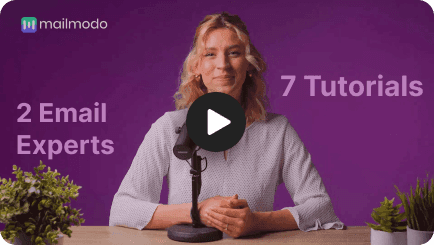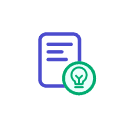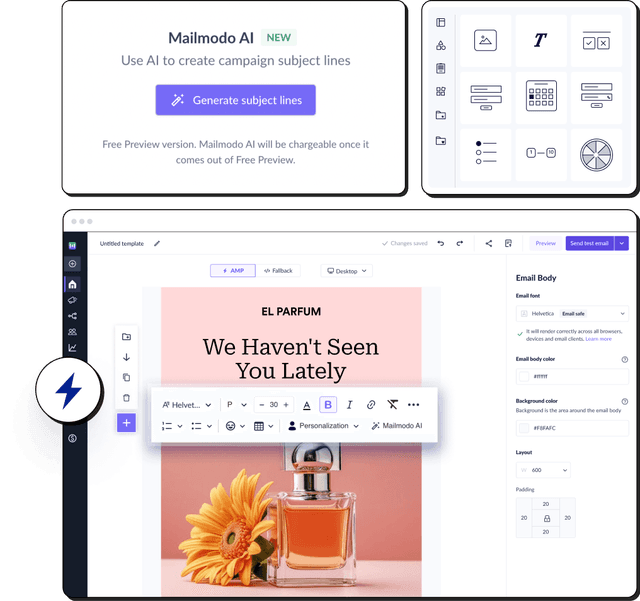Personalization vs. customization
Both personalization and customization aim to create a unique experience for the users. But there's a thin line of difference that separates them.
The difference lies in who makes the changes and how they create them.
| Personalization |
Customization |
| Personalization is done for the user. |
Customization is initiated by the user. |
| Personalization is achieved through customer data and predictive technology. |
Users themselves curate the experience by selecting what they want brands to show to them. |
| For example, Spotify creates a personalized playlist based on the user's saved playlist and songs they listened to. |
For example, Spotify only shows you songs related to the genre you selected when you first signed up. |
Why does website personalization matter?
Personalizing the web content matters because of the following reasons:
• Strengthens customer relationships
Users want to see content that resonates with their preferences, and when you show them exactly that, they feel heard and valued. With personalization, you make the user's experience more humanized. Such experience boosts engagement and conversion metrics.
• Facilitates repeat purchases
The number of consumers who will become repeat buyers after a personalized shopping experience went up to 60% in 2020 from only 44% in 2017. - Segment's State of Personalization Report
With personalization, you can create a unique and more personal experience for each user, which improves brand loyalty and build, trust and encourage make you their go-to brand.
• Get better-qualified leads
Visitors should instantly know your USP and the benefits they can get from it to get good qualified leads. Showing personalized content to target different segments will help you attract leads with a high chance of converting. It will also help your sales team eliminate the time and effort they would spend nurturing cold leads.
Increased customer lifetime value
You want your users to buy from you frequently, and personalized content can help you achieve that goal. Using AI and machine learning-based recommendations, you can show the most relevant content based on their browsing data. It will keep users engaged as you show them what they want to see and thus encourage them to convert, increasing customer lifetime value.
Personalization is especially effective at driving repeat engagement and loyalty over time. Recurring interactions create more data from which brands can design ever-more relevant experiences—creating a flywheel effect that generates strong, long-term customer lifetime value and loyalty.
Mckinsey & Company
How to build your personalization strategy

To give the best-personalized experience to your users, you need to understand the 3W's of personalization:
Why are you personalizing? - The end goal you want to achieve.
Whom are you personalizing for? - Understand your target persona, segment them into different groups based on data
What are you personalizing? - decide what you will show your selected segment to achieve your goals.
Let's discuss each of them in detail.
Why are you personalizing?
Do you want to convert new customers, retain existing ones, or reduce the bounce rate on your product page? Do you want to increase the average order value from a particular segment of your audience?
Your goals will vary depending upon the industry, buyer personas, budget, and resources.
Whom are you personalizing for?
You can't personalize until you know who you want to personalize for, i.e., your target audience. And you can't identify your audience without having the right and adequate data.
Personalization is impossible if you don't have the means to collect and understand the needs and behavior of your customers throughout their lifecycle stage.
Here are a few ways to collect users' data to create a unique digital experience for them:
1. Ask your users directly
Ask your customers about their preferences and interests to collect useful first-party data. There are many ways to collect that data:
Surveys
Send out different surveys, such as feedback surveys, follow-up surveys, NPS, CSAT, etc., via email. To get more responses, try AMP forms, which allows users to submit the form in the email, reducing friction.

Checkout our AMP form templates
Signup forms
Use lead generation or pop-up sign-up forms to collect user data such as demography, industry, and business size.
2. Website cookies
A website cookie is a text file stored on the user's device and tracks visitors browsing history. It collects information like pages visited, IP address, cart details, etc.
This information can be helpful in tailoring content based on whether the user is new or a repeated one.
3. Customer service and sales data
Dig into your customer service and sales data. Talk to a sales rep to get data on what users are saying about your product/services and any feedback that might be useful.
4. Map user's journey
Mapping users' journeys by analyzing different touchpoints through their lifecycle stage can give you a handful of data. By mapping a user's journey, you can deep dive into their behavior. Where do they spend the most time on your page? Which link did they click on, or which e-book did they download? You can collect this by mapping the user's journey.
- For a B2B, some common traits include industry verticals, company size, and funnel stage.
- For e-commerce, it can be past purchases, items added to shopping carts, demography, or location.
Check out our guide on mapping a user's journey to learn in detail.
What can you personalize on your site?
You can begin personalization once you have your goals on the target persona.
For instance, as a SaaS, you want to increase Monthly Recurring Revenue (MRR) by 20% in the next 6 months. And to achieve this goal, you need to upsell your current customers. So, you can personalize your landing page, highlighting the benefits of upgrading to premium plans.
Here are a few elements you can personalize on your homepage and different landing pages to capture the visitors.
Personalize pop-ups using visitors' names, the content they're interacting with, etc. Here is an example of a personalized pop-up by Optionmonster.

Show social proof based on which feature or service users are looking at. Ahrefs is the perfect example of this type of personalization. By tailoring content to specific interests, you can increase relevance. You can also integrate Instagram feed on your website, displaying real-time user experiences that align with the features customers are exploring.
- Personalized product recommendations
You can show recommendations based on the user's browsing history. Many e-commerce brands show recommended products based on the user's interaction history or the product they're viewing. As the products are highly relevant, it might push them to buy more, increasing their average order value.
Here is an example of Myntra's personalized product recommendations

Another way is to show products when users complete the purchase. Here's an example by Sephora

- Add a welcome message for your returning customers.
Bookings.com creates welcome emails for their returning customers to encourage them to signup. It's a good example of connecting with your customers.

- Tailored tutorials and guides
Personalized tutorials and guides offer several benefits, including improving the learning curve, increasing user satisfaction, and reducing information overload.
By tailoring tutorials and guide content to individual users, websites can foster a more meaningful and productive interaction, ultimately benefiting both the users and the website owner. User onboarding software helps you to create tailored onboarding tutosials and guides.
There is no limit to what you can personalize, and the above examples are just some ideas to get you started.
Tools to create personalized content on your website
Here are the six website personalization tools to create a more personalized user experience for your visitors:
- Optimizely
- Google Optimize
- Personyze
- HubSpot
- Dynamic Yield Ltd.
- Evergage
How to tackle the challenges of personalization
No doubt, personalization offers many benefits, but many challenges might discourage businesses from investing resources.
Lack of personnel, budget, and skills are the top challenges while approaching personalization.

Source: Salesforce and Researchscape International, 2020
To create a truly unique experience, understand and develop strategies to tackle such issues.
- Train employees: Equip them with the expertise to learn advanced technology like AI machine learning.
- Review your annual budgeting strategy: Assess the current projects, and redistribute resources to support key priorities such as personalization.
- Encourage collaboration: Allow employees to share and solve problems across the organization, in IT, analytics, product development, and legal.
Website personalization best practices
Here are some of the best practices to follow while setting up personalized content on your site:
Forget personalization if you don't have the means to understand the user's needs and behavior.
To provide a top-notch personalized experience, you need to develop a strong foundation. Analyze different data types, and deploy algorithms to identify behavioral patterns and choices.
This is where a customer data platform (CDP) is essential to execute these tasks. CDPs help you create a 360-degree customer profile by collecting data points through machine learning across channels, cookies, and ad networks. It then enables real-time campaign execution across touchpoints and channels.
• Protect user's privacy
As the user's data is the foundation of personalization, you must be vigilant in using that data. Laws like GDPR and CPRA have strict regulations on users' personal and sensitive information usage.
So, be transparent while collecting the data and ask for the user's consent. Use only the required data to enhance UX and deploy resources to keep user data safe.
• Analyze the channel-wise behavior
What users do and interact with your website can limit your personalization efforts. To create a memorable experience, track their behavior across different channels. Use cross-channel data to develop hyper-personalized content to deliver a unified experience from one touchpoint to the next.
• Don't overdo the recommendations
Too many or too frequent recommendations can make your brand annoying to the readers. After all, your goal is to enhance their experience, not downgrade it.
So, be watchful of what you suggest and diversify your recommendations to keep users engaged on your site.
Website personalization examples
With the spread of AI and machine learning, brands take the user's experience to the heights by personalizing the content. Here are our top 3 picks that we love and couldn't resist sharing.
Amazon
Amazon is among the top brands that leverage personalization to its fullest. 35% of Amazon's sales come through product recommendations done through AI, machine learning, and predictive technology.
Log in to your Amazon account, and you'll see a parade of recommendations based on your previous purchase or search history.
So, they create a unique homepage experience for individual visitors. Amazon's large user base says a lot about the brand and how they aim to create a great experience for their users.
Netflix
You would have noticed how Netflix often changes the movie and web show cover. Besides, the recommendations also keep changing unfailingly. That is Netflix's way of creating a tailored experience for its viewers.
They tailor each experience across many dimensions:
- the suggested videos and their ranking,
- the way videos are organized into rows and pages,
- And even the artwork displayed.
Furthermore, constant a/b testing fuels their personalization, and thus they never fail to delight their users.
















